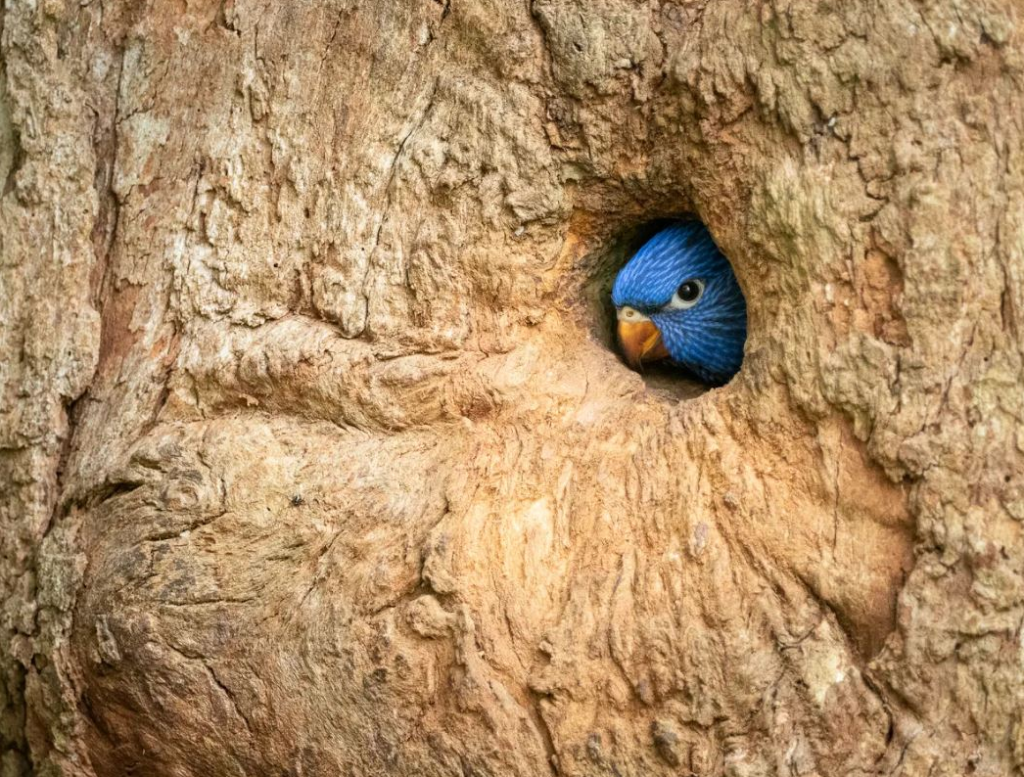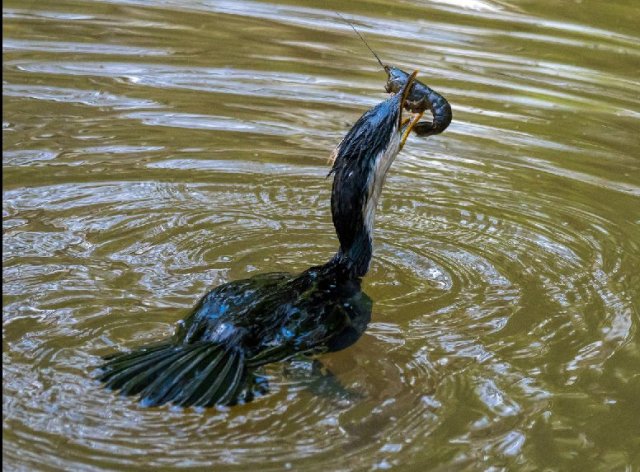Our Fauna page contains data and references to the fauna present within KooyongKoot and its catchment – including links to relevant bird lists (current and historical), plus information on KooyongKoot mammals, threatened species and introduced pests (foxes, cats etc).
The KooyongKoot catchment hosts a wide variety of animals including indigenous resident and visiting fauna The indigenous fauna includes a diversity of birdlife, invertebrates including butterflies and moths, frogs, possums, bats, turtles, fish (eg Freshwater Eels), crustaceans, skinks, beetles, spiders, ants, millipedes, snails, rakali (native water rat) and the occasional visiting grey kangaroo. There are (unwelcome) cases of non-indigenous fauna too – including foxes, carp, domestic cats and rats (black and brown).
Birds

Current Bird Lists
Many bird species can be found along KooyongKoot. Some Friends groups and others conduct regular bird surveys in their patches. These include our member groups the Blackburn Lake Sanctuary Advisory Committee and the Blackburn Creeklands Advisory Committee. We’ll supply lists or links to current lists as and when they become available eg from member groups. Some interesting historical lists appear below.
Sightings can also be viewed through Birdlife Australia’s Birdata and the Atlas of Living Australia – and the now inter-linked iNaturalist.
Case Study: the Tawny Frogmouth (Podargus strigoides)
Athough nocturnal Tawny Frogmouths are difficult to see during the day due to their excellent camouflage, they can sometimes be seen after dark flying and foraging. Their presence along KooyongKoot (Gardiners) Creek is an indicator of a healthy woodland ecosystem.

Nevertheless, Tawny Frogmouth numbers appear to be declining in some Melbourne suburbs. Urgent action is required to avoid them becoming locally extinct.
Causes include tree and other vegetation removals, diminishing habitat corridors, predators and indirect poisoning (eg from rodent baits).
This chart covers the habitat requirements, threats and their mitigation for the Tawny Frogmouth (Podargus strigoides) in depth.
Importance of the KooyongKoot Catchment
James Matcott from Birdlife Australia has shown us just how important KooyongKoot Catchment is to bird life – including the critically endangered Swift Parrots and other endangered, vulnerable and near threatened species.

James noted that the following species are also present:
- Barking Owl recorded in Stonnington (End; FFG)
- Powerful Owls throughout but especially Whitehorse (vulnerable; FFG)
- lots of Hardheads (diving ducks) across the area (vulnerable)
- Musk Ducks between Blackburn Lake and Wattle Park (vulnerable)
- White-throated Needletails (migratory, marine EPBC; vulnerable; FFG)
- Latham’s Snipe (migratory, marine EPBC; near threatened)
- Nankeen Night Heron (near threatened) – loads of them
- Pied Cormorant (near threatened)
FFG = listed in Flora and Fauna Guarantee Act 1988, January 2021 list.
End = Endangered, vulnerable, near threatened etc are from Vic advisory list 2013, unless stated.
We would add the Gang-gang Cockatoos (seen in Blackburn and Box Hill) that have been declared endangered due to major losses in their habitat following the bushfires in recent years.
How Important are the Creeks?
The map below shows sightings of the Laughing Kookaburra:

The importance of water to a bird species varies significantly by species. The map shows sightings of the well-known Laughing Kookaburra – a land bird that nests in hollows in tree trunks. Hollows only appear in old trees and most of the catchment has been cleared for producing coke, firewood, then farming and, later, urbanisation. Remnant old trees tend to follow the creek lines. Presumably, sustenance is more abundant near waterways. Kookaburras, members of the Kingfisher family (Alcedinidae), will also go for a dip in a creek if under heat stress.
Note the way the sightings strongly correlate with Gardiners and Scotchmans Creeks’ streamlines. As James says, the map “clearly shows the value of the Gardiner’s Creek drainage area (inc Scotchmans) and the habitat around the creeks themselves to Kookaburras“.
Historical Bird Lists
This section lists a set of historical bird lists from various areas and at various times within KooyongKoot and its catchment.
| Timespan | Location | List | Author |
|---|---|---|---|
| 1948 – 1954 | Scotch College, Hawthorn | Download PDF file | Students/teachers? |
| 1970s – 1986 | Blackburn Creeklands, Blackburn | Download PDF file | John Humphreys |
| ???? – 2002 | Gardiners Creek Reserve, Burwood | Download PDF file | John Peter |
KooyongKoot Mammals
Platypus and Rakali
Every now and then we get a report of a platypus sighting in the creek. We think they are actually more likely to be sightings of Rakali (Hydromys chrysogaster) which are furry, about the right size and have partially webbed feet – so could easily be mistaken. The Rakali’s tail is a good way to identify it – it is usually fairly slender with a white end – not broad like a platypus’ and not uniformly grey/brown like a large rat’s!
An article by Graham Ross, the KooyingKoot Alliance Creek Keeper, and Geoff Williams from the Platypus Conservancy in a the April, 2022 Eastsider News points out that platypi are breeding in the Yarra at Templestowe and that some (presumably, vagrants from the Yarra) have been spotted in both the Merri and Darebin creeks.
Our creeks are harder for a platypus to access than the latter two creeks because navigating the lower Yarra downstream from Dights Falls to KooyongKoot is significantly more difficult. Perhaps translocation could be the answer? Apparently, that was done for Cardinia Creek. A population of 30 animals would be needed for longer-term viability.
Another enemy is the “Urban Stream Syndrome” which essentially applies to streams being converted to drains as part of urbanization. The problem is that the modified water flows and drainage structures alter the ecology significantly – making them more prone to flash floods, erosion, sedimentation and less able to retain food sources. Man-made barriers such as flood mitigation treatments are significant issues. Finally, urbanization introduces various pollutants and nutrients into streams, such as metals, oils and organic matter.
Returning the platypus to Gardiners Creek would be an exciting prospect but it will take many years of hard work and immense commitment… Improving environmental conditions will help Rakali as well and so, in the interim, we can all take pleasure in having the ‘Aussie otter’ in KooyongKoot.
Geoff Williams, Director Australian Platypus Conservancy (Eastsider News)
It would be wonderful to have the platypus back in our creek. We understand the Merri Creek Management Committee is funding a study to see what works would be needed to restore the Merri Creek to suitable platypus habitat.
Other Mammals
Other than the Rakali described above, the KooyongKoot Catchment hosts a variety of other mammals including possums, bats and …
<more to come>
Pest Animals
The two main pest animals to be found in the KooyongKoot Catchment are cats and foxes. Both severely threaten our ability to improve biodiversity in our catchment.
Cats
Cats are inveterate hunters that take a large toll on our wildlife – they will hunt birds, skinks – anything smaller than them that moves, whether they are hungry or not!. Problem animals fall into two categories: roaming domestic animals and stray, feral or semi-feral cats. In some cases, feral cats have caused the extinction of native ground-dwelling birds and small to medium-sized mammals.
Our photo shows our cat was slavering over a nearby bird along KooyongKoot. That’s no ordinary pigeon either – it’s an indigenous Bronzewing.
Like dogs, cats are controlled by local government Domestic Animal policies and by-laws. Unfortunately, the different municipalities in the KooyongKoot catchment do not have consistent policies regarding cat controls as follows:
- Boroondara: “encourages” cat owners to keep their cat on their property, particularly between dusk and dawn. Council acknowledges that stray and semi-owned cats have a serious impact on local wildlife and that the stray cat population is growing, helped by people feeding unowned cats. Council notes that feeding stray cats but not taking ownership or responsibility for them (including desexing) increases the problem.
- Whitehorse has a cat curfew in place (between 8pm and 6am) to help protect wildlife. Cats are also prohibited from designated bushland parks at all times.
- Monash also has a cat curfew in place (between the later sunset or 7pm (whichever is later) and sunrise) to help protect wildlife. Cats are also prohibited from specific reserves at all times.
- Glen Eira “recommends” cats be confined at night – to protect native wildlife, prevent cat fights, reduce the risk of cats being hit by cars, prevent territorial marking and spraying and help reduce other problems associated with stray cats (eg passing on diseases like Feline AIDS).
- Stonnington has limited published information on cat controls but does note that complaints about wandering cats have increased significantly and that pockets of stray cats are a concern.
Foxes

Metropolitan Melbourne has one of the highest population densities of foxes in the world – a distinctly dubious ‘honour’ !
Foxes are omnivores. There are reports that a mature fox is capable of killing up to 3,000 native animals a year. They also prey on domesticated animals including poultry, rabbits, guinea pigs and aviary birds. They can spread parasites and diseases such as mange and distemper to domestic animals and pets. Feral populations of Red Fox (Vulpes vulpes) have been present in inner Melbourne since the 1930s and have adapted to become part of suburbia.
KooyongKoot neighbours and nearby residents report seeing foxes in their backyards probably coming in from the creek where there are doubtless many dens throughout the catchment – especially along the creek lines. Within an urban setting, the best and safest option for fox control is to discourage them by making the area unsuitable for their survival. Foxes use a variety of shelters such as rubbish heaps, rocky outcrops, patches of woody weeds and buildings.
Actions that can be taken to discourage foxes:
- Remove rubbish and secure bin lids.
- Clean up excess fruit dropped by fruit and berry plants. Foxes are semi-vegetarian – fox scats often contain large amounts of seed.
- Ensure that chickens, guinea pigs and rabbits are securely protected.
- Always cover compost heaps or use a compost bin.
- Don’t feed wildlife (including foxes of course).
- Remove prickly and woody weeds (such as gorse, hawthorn and blackberries) that may provide shelter.
- Fence off the underneath of buildings, water tanks and other places where foxes may hide.
- Don’t leave objects for foxes to climb over into neighbouring properties.
- Remove uneaten pet food and any animal bones or carcasses to prevent foxes scavenging.
- Fence off rock piles, building materials and woodpiles or store them in a manner that does not create a hiding place for foxes.
Other Dangers
People detest rats and mice. A serious new threat to our indigenous wildlife is that people trying to kill rodents are inadvertently killing wildlife.
The problem occurs when wildlife, such as owls, Tawny Frogmouths, Kookaburras and possibly possums like Sugar Gliders eat a poisoned rat or mouse and then become lethally poisoned themselves – by the residual poison in their prey. Some household rat baits contain poisons called Second Generation Anticoagulant Rodenticides (SGARs) which break down very slowly and remain in the food chain for long periods. Unlike Australia, SGARs are banned in many countries because they just keep on killing up the food chain. If you’d like to join the campaign against these poisonings, please visit this link to Birdlife Australia. Here is their handy brochure that helps with selecting safer products.
It doesn’t make sense for us to be killing off birds and other wildlife that naturally control pest rodents! They do it safely and for free… all we need to do is to be discerning with our purchases.


